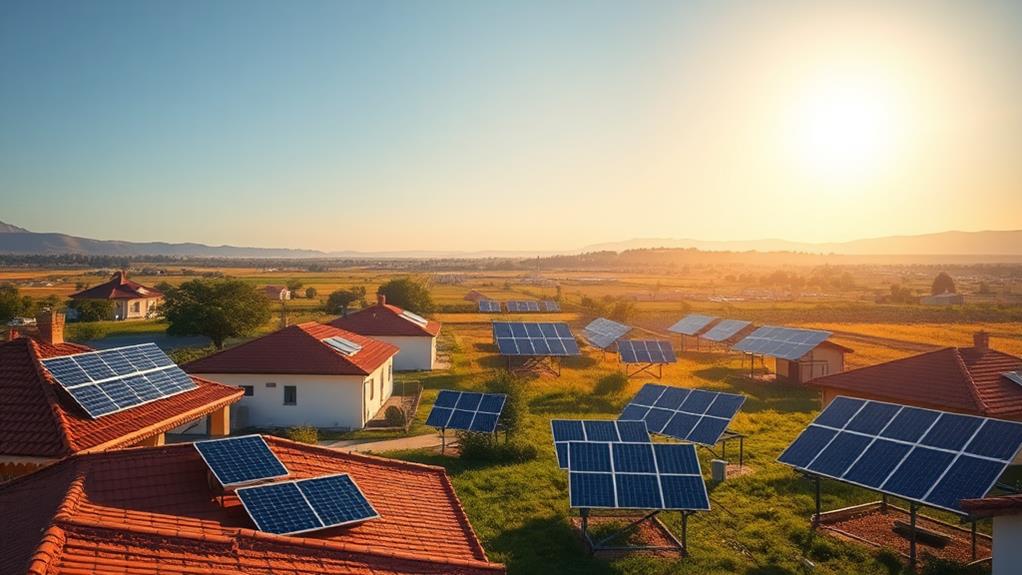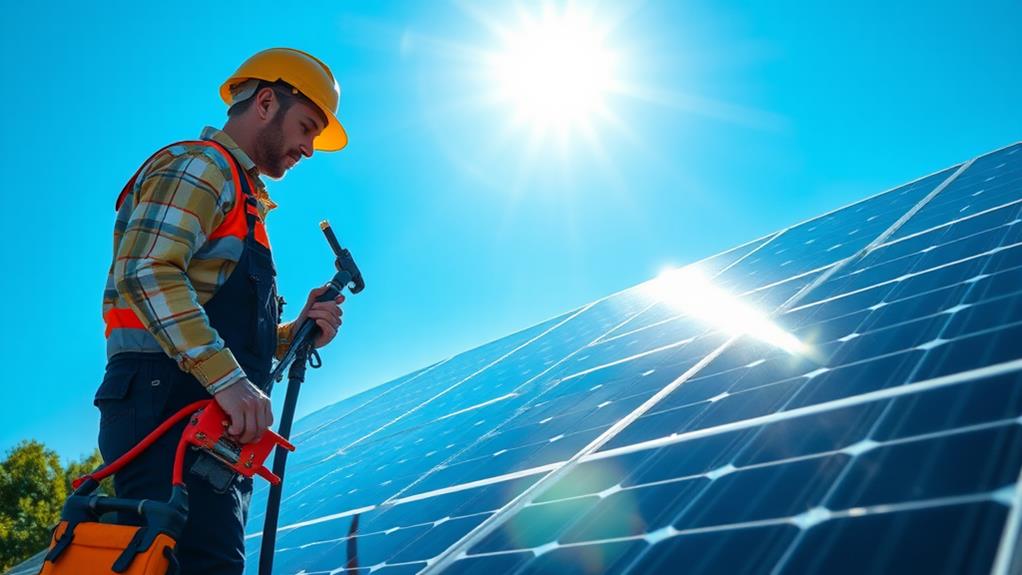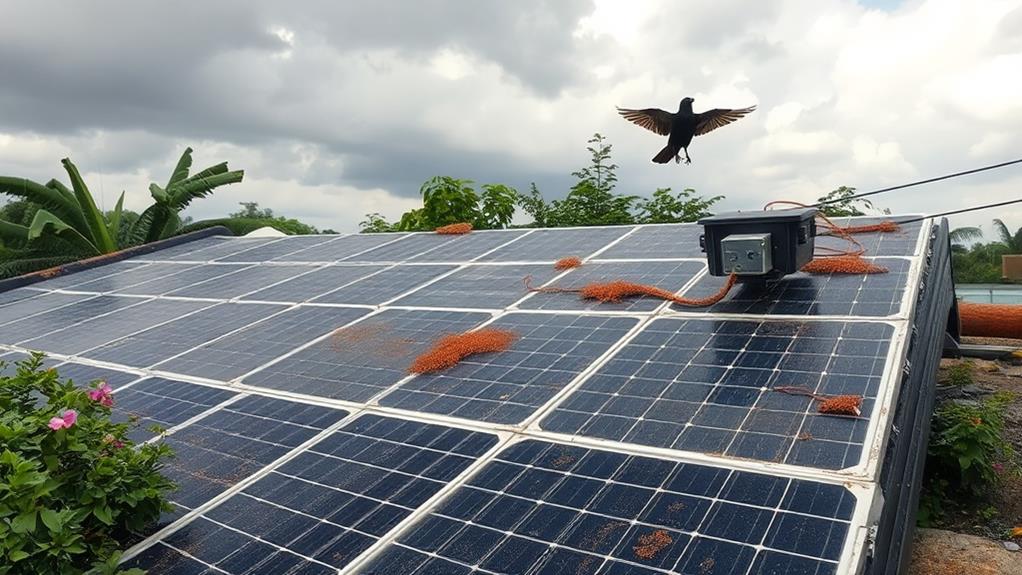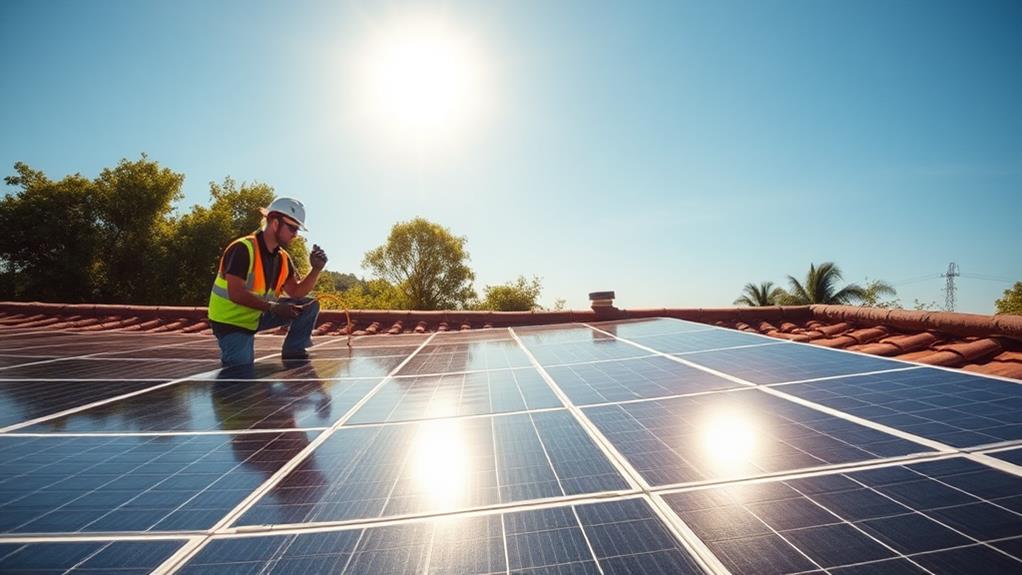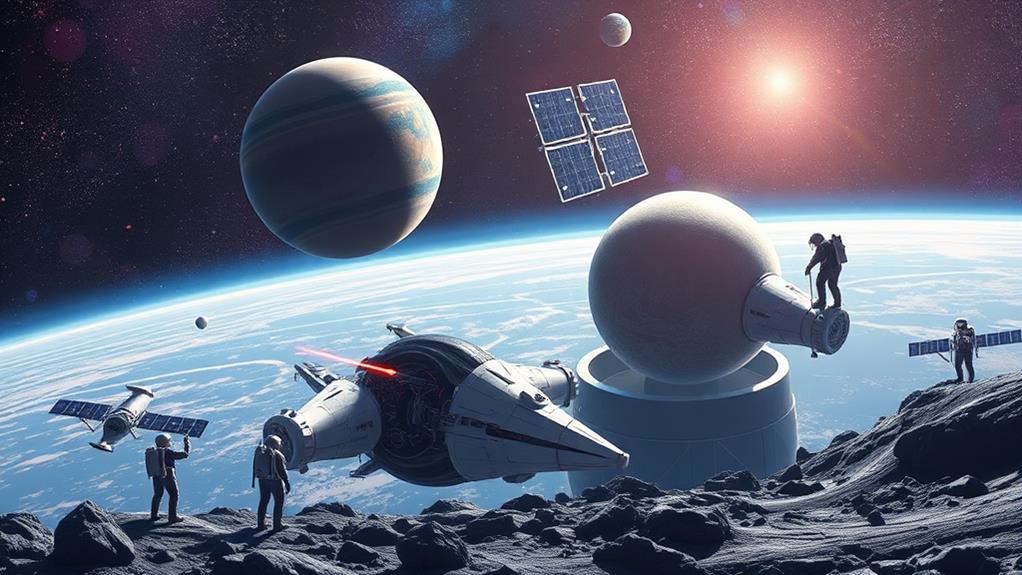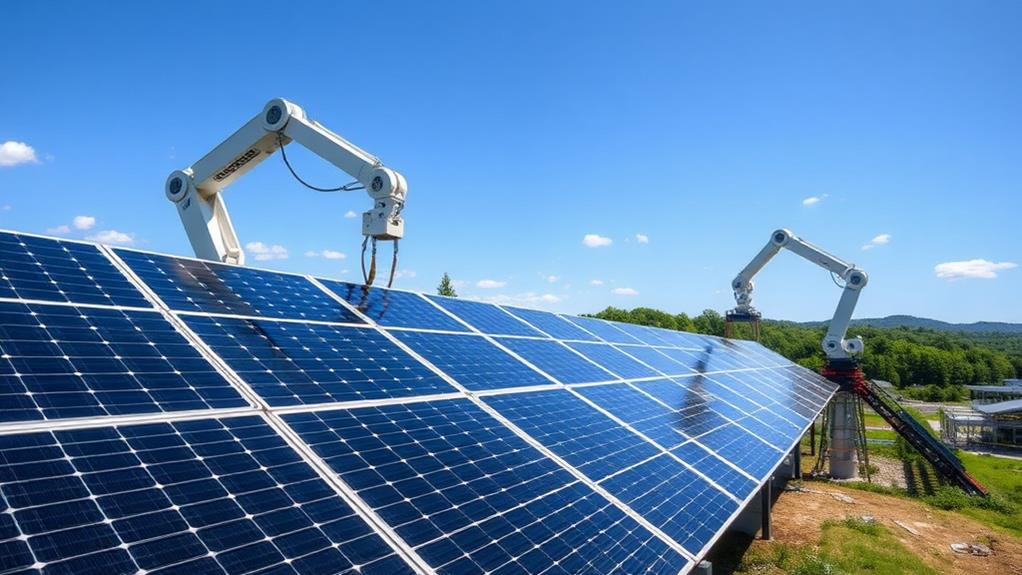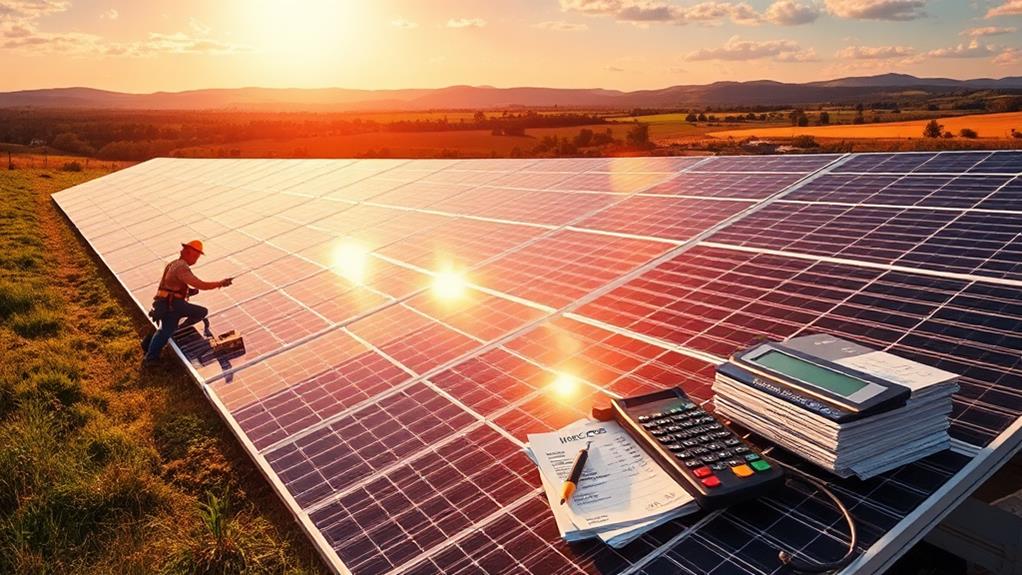When selecting a solar mounting system, we must consider our roof type, orientation, and strength. Fixed systems are cost-effective, while adjustable and tracking systems optimize energy with seasonality and sunlight. Site conditions like soil suitability and local regulations impact ground-mounted choices. Climate, wind loads, and financial constraints also play roles. Expert consultation can guide us through compatibility and cost-analysis, including tax credits and rebates. We should assess maintenance needs and prioritize accessible installations. Durable materials reduce long-term costs. Staying informed on these aspects helps us make informed decisions for a reliable solar setup. Let's uncover more insights together.
Key Takeaways
- Evaluate roof type, orientation, and strength to determine suitable mounting systems.
- Consider climate and geography to decide between fixed, adjustable, or tracking systems.
- Analyze financial constraints, including initial costs, incentives, and long-term benefits.
- Assess site conditions, including space constraints and structural integrity, for optimal system configuration.
- Consult solar panel experts for tailored advice on energy efficiency and regulatory compliance.
Types of Solar Mounting Systems
In the realm of solar mounting systems, several options stand out. Fixed mounting systems remain a popular and economical choice, providing a dependable solution that typically faces south in the Northern Hemisphere or north in the Southern Hemisphere. Although installation is straightforward, these systems mightn't fully capitalise on energy efficiency due to their static configuration.
For those keen on optimising energy capture, adjustable mounting systems allow manual adjustment of panel tilt based on seasonal variations. This option requires more labour and maintenance, which can present additional installation challenges. Despite these hurdles, the potential for improved energy efficiency is a significant advantage. The Renusol VS+ is a reliable choice for those considering adjustable systems, offering robust performance and ease of use.
Tracking mounting systems offer superior energy efficiency by automatically adjusting the panel's position to follow the sun throughout the day. Such systems can boost energy production by up to 40%. Installation tends to be more complex, yet the potential for substantially increased output makes tracking systems an attractive option for those committed to maximising their solar investment. The SunPower Helix Trackers are noteworthy for their innovation and efficiency, making them an excellent choice for those considering this route.
These alternatives provide varied solutions to meet our collective energy goals.
Factors Influencing System Selection
When selecting a solar mounting system, we must consider several key factors to guarantee the best fit for our needs. Initially, assess the site thoroughly, taking into account roof type, orientation, and structural integrity to optimize sunlight exposure.
Next, we should evaluate climate and geographical conditions, along with financial and regulatory constraints, to select a system that aligns with both our energy goals and budget.
Site Assessment Criteria
Choosing the correct solar mounting system requires a thorough site evaluation. Factors such as roof type, orientation, and strength are crucial. Assess whether the roof can support the weight of a solar array, considering its material and structural integrity.
The roof's orientation significantly affects the system's energy efficiency. For ground-mounted systems, consider land orientation and soil compatibility. Confirm that the soil can adequately anchor the mounting structures, ensuring stability and investment longevity.
Adhering to local regulations and potential heritage site restrictions is critical to avoid legal complications. Financial considerations guide the selection of a system that fits within the budget while maximising energy output. Professional advice can align energy needs with the site's unique characteristics, aiding in well-informed decisions.
For example, if your roof is flat, consider a ballasted mounting system which doesn't penetrate the roof surface and is ideal for maintaining structural integrity. In contrast, pitched roofs might benefit from rail-based systems like those offered by Renusol, known for their durability.
For ground-mounted options, the K2 Systems' TerraGrid is suitable for challenging soil conditions, ensuring a stable installation.
Climate and Geography Considerations
Understanding the site's climate and geographical features is as important as evaluating structural factors when selecting a solar mounting system. The local climate influences our choice, guiding us to consider how sunlight exposure changes throughout the year. Fixed, adjustable, or tracking mounting systems might be necessary to harness maximum energy. These systems are designed to maximise the sun's potential.
Wind load requirements demand attention. It's crucial to consider the wind's potential force on solar panels, especially in high-wind areas. This awareness helps select a system that remains robust, offering peace of mind to the community. Evaluating wind loads ensures installations are safe and durable, reflecting a commitment to sustainability.
Environmental conditions and any heritage site restrictions must be acknowledged. Selecting a mounting solution that respects the environment, honours the past, and powers the future is essential. Collective progress towards renewable energy benefits from these thoughtful considerations.
Financial and Regulatory Constraints
Financial and regulatory restrictions significantly influence our selection of solar mounting systems. Understanding how these factors affect our choices assists in identifying the most suitable option for our needs. Fixed mounting systems generally provide more economical alternatives compared to tracking systems. Although tracking systems offer increased energy production, they come with higher costs. Balancing immediate financial constraints with long-term benefits, like return on investment and energy yield, is crucial.
Regulatory considerations are equally important. Local regulations might dictate the types of mounting systems we're allowed to install. Compliance with these regulations and safety protocols is essential to ensure legal adherence and the safety of our installations. Investigating federal solar tax credits can significantly offset the initial costs of our chosen mounting system.
For instance, the South African government offers rebates that could reduce upfront expenses, making systems like Renusol VS+ an appealing choice.
Implementation and Maintenance Considerations
When considering the implementation and maintenance of a solar mounting system, several factors impacting costs and efficiency must be assessed. Cost analysis is crucial. Budget constraints are significant, particularly with tracking systems that have higher initial costs. These systems, although potentially more efficient, demand a thorough evaluation of financial capabilities.
The scale of the operation should be assessed against these costs, ensuring that investment in controllers and calibration is appropriate for specific needs.
Maintenance requirements are also important. Tracking systems are often more complex, necessitating specialised services and parts for upkeep. This complexity can lead to additional costs and time commitments. It's essential to evaluate if the team has the necessary skills or if external assistance is required, which would add to overall expenses.
Accessibility for adjustments and regular maintenance should be prioritised. Ensuring that systems are easily accessible can streamline ongoing maintenance and reduce long-term expenses.
Considering these implementation and maintenance factors will guide towards a wise, sustainable choice aligning with community goals and resources. For instance, the K2 Systems Dome 6.10 is a good option for flat roofs, while the Renusol VS+ is suitable for pitched roofs, ensuring you choose a system that fits your specific requirements.
Importance of Expert Consultation
Consulting experts is crucial when choosing a solar mounting system. Solar panel professionals offer valuable insights into climate suitability and system compatibility, ensuring your selection matches your project's specifications. Their expertise allows you to optimise investments in solar technology, making informed decisions that meet energy needs and budget planning.
Professionals assess specific energy requirements based on site conditions. They assist in maximising energy efficiency while ensuring compliance with safety and regulatory standards. With their tailored recommendations, you can confidently align mounting solutions with financial considerations and energy objectives. It's like having a trusted partner who understands your vision and helps bring it to life.
For example, for areas with high wind loads, the Schletter FS Gen 3 Ground Mount System is recommended due to its durability and adaptability to various terrains.
In contrast, the K2 Systems' Dome 6.10 Flat Roof Mount System is suitable for flat rooftops, offering easy installation and excellent ventilation.
Engaging with experts ensures that the selected systems suit both environmental conditions and performance criteria. This approach safeguards investments and supports long-term sustainability goals, providing peace of mind and efficiency in energy management.
Analyzing Costs and ROI
Analysing the costs and return on investment (ROI) of a solar mounting system is essential for making a sound financial decision. Conducting a thorough cost comparison and ROI analysis ensures the selection of the right system. Examining energy savings and available incentives allows for the calculation of ROI and understanding the payback period of the investment. It's crucial to weigh the initial outlay against ongoing operating costs throughout the system's lifespan.
Material durability significantly influences this analysis. High-quality materials enhance long-term performance and reduce maintenance needs, thereby decreasing costs over time. Consider the impact of installation and maintenance expenses as part of a comprehensive cost analysis to avoid unexpected financial burdens.
For instance, the Clenergy PV-ezRack system is known for its robust design, reducing maintenance frequency.
Tracking system accuracy and terrain adaptability is vital for maintaining efficiency. A system that adapts well to the unique environment can significantly optimise performance, ensuring maximum ROI. A good example is the Schletter Solar Mounting System, which offers excellent adaptability to various terrains.
Engaging in a detailed cost comparison and focusing on material durability equips us to select a solar mounting system that aligns with financial and environmental goals, fostering a sense of belonging in the sustainable energy community.
Assessing Site and Space Conditions
As we evaluate our site's suitability for a solar installation, we need to examine the type of roof to guarantee it can support the mounting system safely and effectively.
We'll also analyze any space constraints, measuring the available square footage to determine how many panels we can accommodate.
Moreover, evaluating the structural integrity of the roof is essential to confirm it can handle the load of the solar panels without compromising safety or performance.
Roof Type Evaluation
When assessing the roof type for a solar mounting system, several critical factors must be considered to ensure a successful installation. The type of roof significantly affects the choice of mounting systems.
For flat roofs, ballasted systems are often preferred. These systems use weight to secure the panels without penetrating the roof surface, preserving roof integrity while supporting the solar array.
Sloped roofs, on the other hand, typically require adjustable mounts. These mounts allow the panels to be positioned at the optimal angle, maximising sunlight exposure and enhancing energy efficiency.
The evaluation extends further. It's vital to assess the roof's load capacity to ensure it can support the weight of the panels and mounting system. This involves understanding the roof's structural strength and the potential for shading from nearby trees or buildings, which could impact system performance.
Selecting suitable mounting materials based on the roof type and environmental factors ensures resilience and long-term performance. Considering these elements helps construct a solar system that aligns with energy objectives while fostering a sense of community and shared environmental responsibility.
Space Constraints Analysis
Understanding roof types is just the beginning. Space constraints significantly influence the solar installation process. Efficient space utilisation is key to maximising energy production. It's not merely about the number of panels; it's about optimising the available area to meet energy objectives.
Space conditions guide our choices in mounting options, balancing structural integrity with energy goals. Limited space doesn't imply limited potential. Creative strategies can optimise space use, ensuring maximum energy is harnessed from every square metre.
Space availability affects installation feasibility and production capacity. Roof integrity and load capacity are crucial in selecting mounting structures. Evaluating these factors helps identify the best configuration for specific needs. This involves making informed choices that satisfy requirements and align with a shared vision for sustainability. Together, we can overcome these limitations to unlock the full potential of solar energy.
Structural Integrity Assessment
Regular analysis of the structural integrity of your site is essential when planning a solar installation. Evaluating the load capacity is crucial to ensure it can support the weight of the solar panels and withstand additional loads such as snow and wind. This step safeguards our investment and ensures a sustainable energy solution.
Inspect the orientation and tilt of the mounting system, considering geographical location, to optimise sunlight exposure and enhance energy production efficiency.
Assess available space and surface type to determine the most suitable mounting system, whether for flat roofs, sloped roofs, or ground installations. This decision significantly impacts the overall stability and performance of the solar setup.
Focus on material selection for the mounting structure. Prioritise materials known for their durability, weather resistance, and corrosion protection. Aluminium and stainless steel are excellent choices, ensuring longevity in various environmental conditions.
Conclusion
When choosing the right solar mounting system, we need to consider various factors, such as system types, site conditions, and costs. By examining these elements, we can ensure an efficient solar setup. It's important to consult with experts who can guide us through the details of implementation and maintenance. With their help, we'll maximise our investment and achieve a sustainable energy solution. Let's make informed choices for a better future together.
If you have any questions about our products or services, contact us at Deo Solar. We offer a range of products, including Rail-Less Solar Brackets, End Spacers, Structural Brackets, Ground Mounted Solar Systems, Corrugated Brackets, and Earthing Plates. Our services include the DeoSizer Tool, Evaluation and Design, Maintenance and Support, and Solar Installations. We're here to help you every step of the way.

